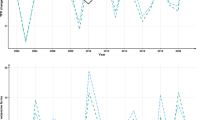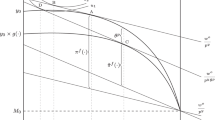Abstract
This paper employs a three stage procedure to investigate labor productivity growth and convergence in the Kansas farm sector for a balanced panel of 564 farms for the period 1993–2007. In the first stage, Data Envelopment Analysis is used to compute technical efficiency indices. In the second stage, labor productivity growth is decomposed into components attributable to efficiency change, technical change, and factor intensity. The third stage employs both parametric and semiparametric regression analyses to investigate convergence in labor productivity growth and the contribution of each of the three components to the convergence process. Factor intensity and efficiency change are found to be sources of labor productivity convergence while technical change is found to be a source of divergence. Policies that encourage investment in capital goods may help to mitigate disparities in labor productivity across the farm sector.




Similar content being viewed by others
Notes
Beta convergence occurs when the partial correlation between growth in productivity over time and its initial level is negative. Sigma convergence occurs when the dispersion of productivity growth across a group of firms, states, or economies falls over time.
When the average annual growth rate of labor productivity is regressed against initial labor productivity, the fit of this regression tests for absolute (unconditional) β-convergence. When other control variables are included in the regression, the regression tests for conditional (relative) β-convergence. Kansas farms are heterogeneous and binary variables are included in the regression models to control for farm size.
Serra et al. (2005) found that the introduction of fixed decoupled payments in 1996 may have reduced the likelihood of off-farm labor participation. However, government payments that reduce farm household participation to non-farm markets increased after 1996 thus motivating a higher participation in on-farm labour markets.
The period 1997–1998 were El Nino years. El Nino winters are expected to be wet in the Great Plains but this period was very dry. The November-January period was one of the driest on record in Kansas and winter wheat deteriorated badly with the worsening drought.
Comparing 2006–2007, corn prices increased from 2.41 to 3.63 per bushel, grain sorghum prices increased from 4.14 to 6.29, soybean prices increased from 5.51 to 7.84, and wheat prices increased from 4.38 to 5.92.
Asset charges include repairs, rental charges for land and machinery, auto and conservation expense, cash interest, real estate and property taxes, general farm insurance, depreciation, and opportunity interest charged on owned equity. Purchased inputs include fuel and oil, seed, fertilizer and lime, chemicals, feed, utilities, and crop insurance.
The purchased input price (Purinp) is a weighted average of USDA agricultural price indices for fuel, seed, fertilizer, services, chemicals, and feed. The asset charges (Capp) price is a weighted average of USDA agricultural price indices for repairs, services, rent, and interest prices. The weights are determined using cost shares.
Test of β-convergence is obtained by estimating the following equation:
\( (1/T) \cdot \log (y_{iT} /y_{i,0} ) = a + b \cdot \log (y_{i,0} ) + \alpha Z_{i,T} + \mu_{i0,T} \) where \( y_{iT} \) and \( y_{i0} \) are labor productivity at the beginning and the end of time interval (T), Z represent binary variables that control for farm size, and \( \mu_{i0,T} \) is random error term. If we interpret this as a the transition toward a steady state growth rate, then b is a measure of the speed of convergence—the fraction of gap between current labor productivity growth and the long-run value that is reduced each period. The actual speed of convergence, \( \hat{\beta } \), varies directly with the estimated parameter, \( \hat{b} \), and are computed as follows: \( \hat{\beta } = {{ - \log \left( {1 + \hat{b}} \right)} \mathord{\left/ {\vphantom {{ - \log \left( {1 + \hat{b}} \right)} T}} \right. \kern-\nulldelimiterspace} T} \). Significant estimates of \( \hat{\beta } \)are obtained if \( \hat{b} \) is significant.
The semi-parametric regression models (PLM and SCM) are appropriate when the parametric model (OLS) fails the test of correct model specification, as indicated by the parametric misspecification test. The models are used as a benchmark for the parametric model because the true functional form and data generation process of the parametric regression that fails the specification test is unknown. The added value of semi-parametric techniques consists in their ability to deliver estimators and inference procedures that are less dependent on functional form assumptions.
Those figures are computed by taking the antilog of initial labor productivity as depicted on the graphs.
References
Ball VE, Norton GW (2002) Agricultural Productivity: measurement and Sources of Growth. Kluwer Academic Publishers, Boston
Ball VE, Gollop FM, Kelly-Hawke A, Swinand G (1999) Patterns of state productivity growth in the US farm sector: linking state and aggregate models. Am J Agric Econ 81:164–179
Ball VE, Bureau JC, Butault JP, Nehring R (2001) Levels of farm sector productivity: an international comparison. J Prod Anal 15:5–29
Ball VE, Hallhan C, Nehring R (2004) Convergence of productivity: an analysis of the catchup hypothesis within a panel of states. Am J Agric Econ 86:1315–1321
Carree MA, Klomp L (1997) Testing the convergence hypothesis: a comment. Rev Econ Stat 79:683–686
Coelli T, SP Rao D, O’Donnell CJ, Battese GE (2005) An introduction to efficiency and productivity analysis, 2nd edn. Springer, New York
Delgado-Rodriguez MJ, Álvarez-Ayuso I (2008) Economic growth and convergence of EU member states: an empirical investigation. Rev Dev Econ 12(3):486–497
Färe R, Grosskopf S, Margaritis D (2006) Productivity growth and convergence in the European Union. J Prod Anal 25:111–141
Gutierrez L (2002) Why is agricultural labor productivity higher in some countries than others? Agric Econ Rev 3(1):58–72
Härdle W, Mammen E (1993) Comparing nonparametric versus parametric regression fits. Ann Stat 21:1926–1947
Henderson JD, Russell RR (2005) Human capital and convergence: a production-frontier approach. Int Econ Rev 46:1167–1205
Henderson DJ, Zelenyuk V (2007) Testing for (efficiency) catching-up. South Econ J 73:1003–1019
Horowitz JL, Härdle W (1994) Testing a parametric model against a semiparametric alternative. Economet Theory 10:821–848
Horowitz JL, Spokoiny VG (2001) An adaptive, rate-optimal test of a parametric mean- regression model against a nonparametric alternative. Econometrica 69:599–631
Hsiao C, Li Q, Racine JS (2007) A consistent model specification test with mixed discrete and continuous data. J Economet 140:802–826
Koop G, Tobias JL (2006) Semiparametric Bayesian inference in smooth coefficient models. J Economet 134:283–315
Kumar S, Russell RR (2002) Technological change, technological catch-up, and capital deepening relative contributions to growth and convergence. Am Econ Rev 92:527–548
Langemeier M (2010) Kansas farm management SAS data bank documentation. Staff Paper No. 11–01. Department of Agricultural Economics, Kansas State University, USA
Li Q, Racine JS (2007) Nonparametric econometrics: theory and practice. Princeton University Press, New Jersey
Li Q, Huang CJ, Li D, Fu T (2002) Semiparametric smooth coefficient models. J Bus Econ Stat 20:412–422
Liu Y, Shumway CR, Rosenman R, Ball VE (2008) Productivity growth and convergence in US agriculture: new cointergration panel data results. Working Paper No. 2008-4. School of Economic Sciences, Washington State University
Managi S, Karemera D (2004) Input and output biased technological change in the US agriculture. Appl Econ Lett 11:283–286
McCunn A, Huffman WE (2000) Convergence in US productivity growth for agriculture: implications of interstate research spillovers for funding agricultural research. Am J Agric Econ 82:370–388
Rezitis AN (2005) Agricultural productivity convergence across Europe and the United States of America. Appl Econ Lett 12:443–446
Serra T, Goodwin BT, Featherstone AM (2005) Agricultural policy reform and off-farm labour decisions. J Agric Econ 56:271–285
Serra T, Zilberman D, Gil JM (2008) Farm’s technical Inefficiencies in the presence of government programs. Aust J Agric Resour Econ 52:57–76
Shephard RW (1970) Theory of cost and production functions. Princeton University Press, Princeton
United States Department of Agriculture, National Agricultural Statistics Service, Kansas Field Office. (2010). Kansas Farm Facts 2010
Yatchew A (2003) Semiparametric regression for the applied econometrician. Cambridge University Press, New York
Author information
Authors and Affiliations
Corresponding author
Rights and permissions
About this article
Cite this article
Mugera, A.W., Langemeier, M.R. & Featherstone, A.M. Labor productivity convergence in the Kansas farm sector: a three-stage procedure using data envelopment analysis and semiparametric regression analysis. J Prod Anal 38, 63–79 (2012). https://doi.org/10.1007/s11123-011-0235-1
Published:
Issue Date:
DOI: https://doi.org/10.1007/s11123-011-0235-1
Keywords
- Labor productivity
- Efficiency change
- Technical change
- Factor intensity
- Convergence
- Semiparametric regression





